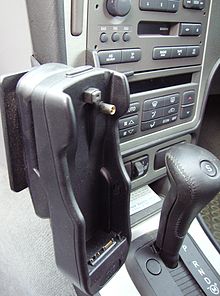Speakerphone
A hands-free system , hands-free system or HFCK is a combination of a loudspeaker and microphone permanently installed in a device (e.g. mobile phone ) or vehicle. The name is derived from the fact that neither loudspeaker nor microphone need to be brought to the ear or mouth, so the hands remain free . Therefore the term is wrongly used for microphone-headphone combinations, so-called headsets .
In contrast to radio devices, which use FSE only in two-way operation (half duplex) , feedback occurs during telephone calls (in full duplex) via FSE . With feedback suppressors, however, it is possible to speak freely without isolating the listener at the ear and without a push-to-talk button. With more complex FSE, ambient noises are suppressed by analyzing the signals from several microphones. This ensures intelligibility even in noisy environments and reliably enables the use of speech recognition to control devices (e.g. language selection).
variants
- in the telephone , as an alternative to the handset
- in motor vehicles
- as a door speakerphone
- in call pillars
Hands-free device in motor vehicles
Legal requirements
Germany
Since the beginning of 2001 in Germany when making calls hands-free car in passenger cars according to § 23 para. 1a StVO (D) absolutely necessary as long as the engine of the vehicle is running and this does not stand still; the requirement applies to all vehicle drivers, including cyclists . According to Section 23 (1b) sentence 2, this also applies expressly to vehicles with a stop-start system . The Hamm Higher Regional Court decided that they were not affected by the ban under Section 23 of the StVO until October 19, 2017 .
Austria
Since July 1, 1999, it has been mandatory for drivers in Austria to use a hands-free device when making phone calls while driving. The corresponding provisions can be found in Section 102 (3) sentences 5 to 7 of the Motor Vehicle Act (KFG). Furthermore, Section 58 (1) of the Austrian Road Traffic Regulations implicitly prohibits driving a vehicle if the driver is distracted from the traffic.
Investigations
In September 2004, a study by the Swedish National Research Institute for Roads and Transport (VTI) showed that these devices do not increase road safety, as the phone itself distracts attention .
In 2005, several studies again demonstrated that hands-free systems did not reduce the risk of accidents caused by telephoning. An Australian study even came to the conclusion that hands-free systems entice motorists to make more frequent and longer phone calls while driving and therefore actually increase the risk of accidents.
In addition to road traffic law, there are also provisions of the vehicle manufacturers. In motor vehicles (built from 1995 onwards) the commissioning of a transceiver system ( commercial radio , BOS radio , amateur radio , public radio , cellular phone / mobile phone / car phone ) is only permitted if an external antenna installed in accordance with the manufacturer's guidelines is available, otherwise the general Operating permit (ABE) expire.
technology
In the case of hands-free systems, a distinction is essentially made between “plug and play” and fixed installation solutions. In contrast to built-in hands-free systems, “plug and play” systems are plugged into the vehicle's cigarette lighter and then connected to the mobile phone. The microphone and loudspeaker are often integrated in the device.
In both cases, it can be operated either via the mobile phone itself, via the hands-free system, or - with the fixed installation solution - via the steering wheel buttons.
Another difference is the connection to the mobile phone: A distinction is made between bracket-based and bracket-less solutions. In the first case, the mobile phone is placed in a holder that is different for each type.
Today's trend is towards hold-up solutions. The mobile phone usually communicates with the hands-free system wirelessly via Bluetooth . The mobile phone can be anywhere in the vehicle, e.g. B. in the coat pocket or in the trunk. This eliminates annoying cables; however, automatic recharging of the phone battery is also not possible. The SIM Access Profile (SAP), also called rSAP, is becoming more and more important . It offers significant advantages over the hands-free profile, such as: B. the use of the vehicle's external antenna. New developments will even make it possible to output music from a mobile phone or navigation instructions from navigation software installed there via the vehicle speakers.
